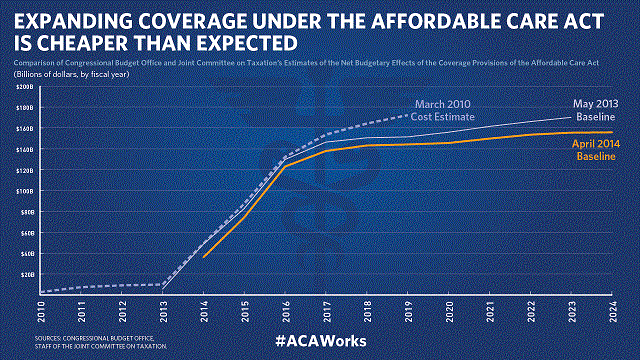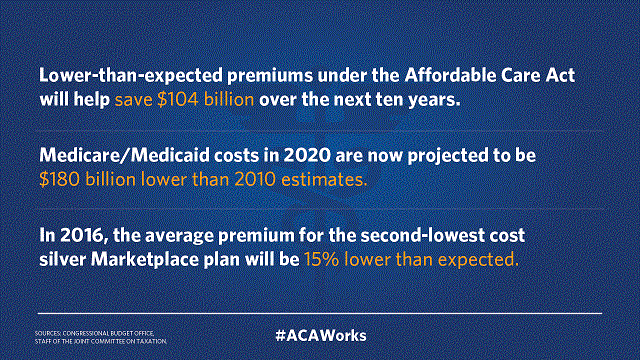The White House
Office of the Press Secretary
For Immediate Release
April 17, 2014
FACT SHEET: Affordable Care Act by the Numbers
The Affordable Care Act is working. It is giving millions
of middle class Americans the health care security they deserve, it is slowing
the growth of health care costs and it has brought transparency and competition
to the Health Insurance Marketplace.
HEALTH CARE BY THE NUMBERS
- 8 million people signed up for private
insurance in the Health Insurance Marketplace. For
states that have Federally-Facilitated Marketplaces, 35 percent of those who
signed up are under 35 years old and 28 percent are between 18 and 34 years
old, virtually the same youth percentage that signed up in Massachusetts in
their first year of health reform.
- 3 million young adults gained
coverage thanks to the Affordable Care Act by being able to
stay on their parents plan.
- 3 million more people were enrolled in
Medicaid and CHIP as of February, compared to before the
Marketplaces opened. Medicaid and CHIP enrollment continues year-round.
- 5 million people are
enrolled in plans that meet ACA standards outside the
Marketplace, according to a CBO estimate. When insurers set
premiums for next year, they are required to look at everyone who enrolled in
plans that meet ACA standards, both on and off the Marketplace.
- 5.7 million people will be
uninsured in 2016 because 24 States have not expanded
Medicaid.
HEALTH CARE COST GROWTH IS LOWEST IN DECADES

- Health care costs are growing at the
slowest level on record: Since the law passed, real per
capita health care spending is estimated to have grown at the lowest rate on
record for any three-year period and less than one-third the long-term
historical average stretching back to 1960. This slower growth in spending is
reflected in Medicare, Medicaid, and private insurance.
- CBO projects the deficit will shrink more
and premiums will be lower than expected: CBO previously
estimated that the ACA will reduce the deficit by $1.7 trillion over two
decades, and, just this week, CBO concluded that lower-than-expected
Marketplace premiums and other recent developments will cut $104 billion from
our deficit over the next ten years. The CBO report also projects that
lower-than-expected premiums will help to save $5 billion this year, and that
lower premiums will persist in the years ahead, remaining 15 percent below
projections by 2016 (the only year in which CBO provides a precise
estimate).
- Medicare spending growth is
down: Medicare per capita spending is growing at
historically low rates. This week, for the fifth straight year, the CBO
reduced its projections for Medicare spending over the next 10 years – this
time by $106 billion. CBO projects that Medicare and Medicaid costs
in 2020 will be $180 billion below its 2010 estimates. Recent economic
research suggests that the ACAfs reforms to Medicare may have gspillover
effectsh that reduce costs and improve quality across the health care system,
not just in Medicare.

THE SECURITY OF HEALTH INSURANCE
FOR MILLIONS OF MIDDLE CLASS FAMILIES
- Up to 129 million Americans with pre-existing
conditions – including up to 17 million children – no longer have to worry
about being denied health coverage or charged higher premiums because of their
health status.
- 71 million Americans with private insurance have gained
coverage for at least one free preventive health care service such as
mammograms, birth control, or immunizations in 2011 and 2012.
- In 2013, 37 million people with Medicare received at
least one preventive service at no out of pocket cost.
- Approximately 60 million Americans have gained
expanded mental health and substance use disorder benefits and/or federal
parity protections.
- Since the health care law was enacted, almost 8 million
seniors have saved nearly $10 billion on prescription drugs as the
health care law closes Medicarefs gdonut hole.h
- 105 million Americans no longer have to worry about
having their health benefits cut off after they reach a lifetime limit.